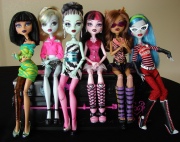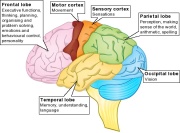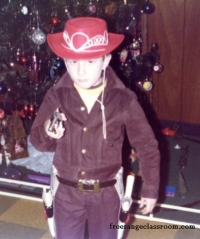 I have to say that I don’t agree with this ongoing doll debate-whether its Barbie, Bratz, “Little Miss Poops-A-Lot” with real diapers, or otherwise.
I have to say that I don’t agree with this ongoing doll debate-whether its Barbie, Bratz, “Little Miss Poops-A-Lot” with real diapers, or otherwise.
I will say this again (in my outdoor voice): THESE ARE F-ING DOLLS-toys- and you have to give kids credit for understanding this. They DON’T look like real people because they are TOYS.
Can’t kids just play creatively anymore without someone picking apart the “hidden meaning” of what they are doing, or someone trying to ban harmless fun? (That in itself is a topic for another post.) If we are that concerned with what our kids think about the toys we buy for them-then that is an issue of either encouraging flawed thinking-or buying toys that are not age-appropriate. Its not an issue with the toy itself, that has no actual power on its own.
The only way a child can get the “wrong idea” from dolls (or any toy), is if the dolls talk to the kids on their own, (and then you have an altogether different problem) or if a (well-meaning) adult is projecting their own doubts, fears and insecurities onto the children and their dolls. Other wise, I think we are making too big of an issue of this “dolls and self image” idea, and need to just relax, leave them alone and let them play.
If ‘your 4 year old daughter’, for example, plays with these dolls and then ‘equates sexuality with popularity and power’, (as one blogger wrote), then maybe you need to re-evaluate exactly what values YOU are teaching your 4 year old. They don’t learn this from an inanimate object-but from other human beings: parents, family, educators and peers. Find better (living/human) role models.
This article (link below) talks about how the Monster High dolls are only modified versions of Barbie. But as you read, you will see that the piece itself does not encourage diversity & acceptance at all-but criticism & exclusion. The author suggests that along with Barbie, we should reject these dolls too, based on their flaws being non-flaws.
How does this line of thinking support acceptance/diversity/individuality? Rejection is still rejection & exclusion is still exclusion.
In addition, the article selectively cites specific flaws that support the writer’s point of view-however it does not look at, as one reader pointed out, the positives that the doll’s flaws & characteristics can teach kids-such as the Zombie doll only speaking zombie, and walking very slowly, which can be something that a child with special needs or speech difficulties can fully embrace. Each child will look at these dolls through their own lens-just as the adults seem to be doing.
The author feels that the line reflects “a disturbing obsession with body image” and prints a few descriptions, one belonging to the Clawdeen Wolf doll, who has hairy wolf legs, as an example.
Now, maybe I’m living on a different plane of existence, or maybe I am just disturbingly obsessed with body image, but I think that is just hilarious! I think it reflects a very human (female) quality: which one of us has never marveled at how, in the summer, when its shorts and flip-flop season, the hair on your legs seems to grow back 10 minutes after you’ve shaved?
So now I ask you, is that in itself a disturbing obsession with body image or a matter of self-care, pride in one’s appearance, comfort and hygiene?
The point is, children learn what we teach them-and what we allow them to learn. What they learn on their own-what perceptions they have- will depend partly on their personality and partly on how WE teach them to perceive things. If you only show them one side of the coin, then they will tend to only look at that one side, no matter who the person or what the situation.
So rather than being critical, and freaking out over kid’s toys, wouldn’t it make more sense to show BOTH sides of the coin-and to also find the positives that these dolls can teach, rather than resorting to the politically correct “jump on the diversity bandwagon” or the “reject what I don’t understand” approach? Why does our thinking have to be so polarized and why does everything have to be either an “epidemic” or a crisis?
Use the Force: Its called “open mindedness” also known as “imagination” and its got unlimited potential to empower, and to help develop and build on positive – or negative – characteristics in kids.
We all have positive attributes-and negatives-and they are all valuable in helping us to learn about ourselves and about the people and the world around us. WE can set the example: embrace them, flaws and all, and stop hovering over kids. Stop being so critical about toys, particularly dolls, as I hope we would strive to do with other people. Wouldn’t we want our kids-especially our girls-to do the same?
Read the original article here:
Goth Barbie Celebrates ‘Freaky Flaws’ by Looking Like Regular Barbie
Food for Thought:
I want to hear from you: Are these just “F-ing Dolls” or “Bad Examples” ?
.



